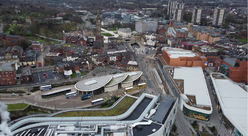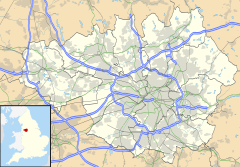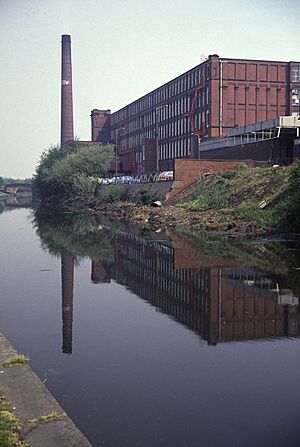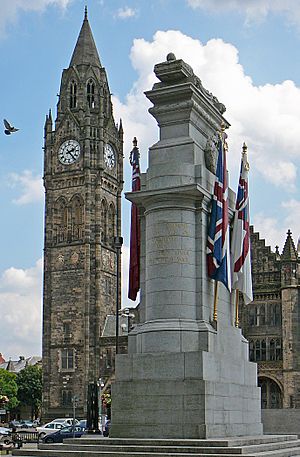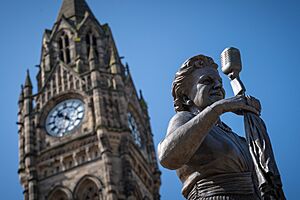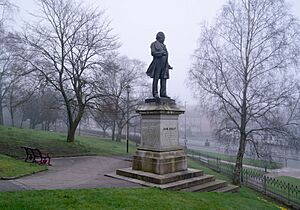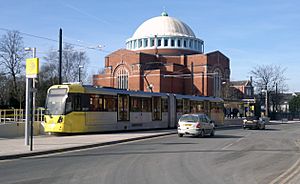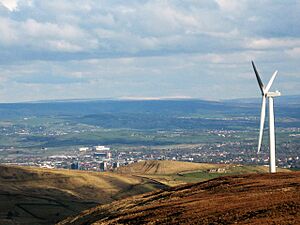Rochdale facts for kids
Quick facts for kids Rochdale |
|
|---|---|
| Town | |
|
Rochdale Town Hall, St Chad's Church, Number One Riverside, Milkstone Mosque and Rochdale Town Centre skyline |
|
| Area | 22 sq mi (57 km2) |
| Population | 111,261 |
| • Density | 5,057/sq mi (1,953/km2) |
| OS grid reference | SD893130 |
| • London | 222 mi (357 km) SSE |
| Metropolitan borough |
|
| Metropolitan county | |
| Region | |
| Country | England |
| Sovereign state | United Kingdom |
| Post town | ROCHDALE |
| Postcode district | OL11, OL12, OL16 |
| Dialling code | 01706 |
| Police | Greater Manchester |
| Fire | Greater Manchester |
| Ambulance | North West |
| EU Parliament | North West England |
| UK Parliament |
|
Rochdale is a town in Greater Manchester, England. It's the main town of the Metropolitan Borough of Rochdale. In 2021, about 111,261 people lived in Rochdale. The town sits at the bottom of the South Pennines hills. It's located in the valley of the River Roch. Rochdale is about 5 miles (8 km) north-west of Oldham. It's also about 10 miles (16 km) north-east of Manchester.
Rochdale's story goes way back. It was first written about in the Domesday Book in 1086. Back then, it was called Recedham Manor. But its history might go back even further, to the 9th century. Rochdale was once a very large church area. It included many smaller parts called townships. By 1251, the town was important enough to get a special permission called a royal charter.
The town became a big center for trading woollen cloth. By the early 1700s, it was known for its "wealthy merchants." In the 1800s, Rochdale grew into a mill town. It became a key place for making textiles during the Industrial Revolution. Historically, Rochdale was part of Lancashire. It was a special county borough within Lancashire until 1974.
Contents
- Discovering Rochdale's Past
- How Rochdale is Governed
- Rochdale's Location and Landscape
- People of Rochdale
- Famous Landmarks in Rochdale
- Getting Around Rochdale
- Learning in Rochdale
- Media and News
- Places of Worship
- Public Services
- Sports in Rochdale
- Rochdale's Twin Towns
- Notable People from Rochdale
- Images for kids
- See also
Discovering Rochdale's Past
Rochdale's Early Days
A Roman road once crossed the moors near Rochdale. This road connected Mamucium (Manchester) to Eboracum (York).
The area around Rochdale was sometimes attacked by the Danes. A castle that Castleton is named after might have been destroyed during fights between the Saxons and Danes. In 1086, the Domesday Book mentioned Rochdale as Recedham. It was part of the Salford area and Cheshire county.
In medieval times, Rochdale held weekly markets. These markets started around 1250. They were held near the main church.
How Rochdale Got Its Name
The town's name was written as Recedham in the Domesday Book. In 1193, it was called Rachetham. Over time, the name changed. The ending -ham (meaning homestead) became -dale (meaning wide valley).
The name Rachdale was used for the town in 1242. It might have been used for the valley even earlier. The name reced in Old English might mean "hall."
The river that runs through the town is called the River Roch. Even though the river's name is pronounced with a long 'o' sound, Rochdale is pronounced with a shorter 'o' sound.
The Industrial Revolution in Rochdale
Rochdale really grew because of the Industrial Revolution. But making woollen cloth was important here even in the 1500s. At first, people made textiles at home. Later, in the late 1700s, mills powered by water started to appear.
In the 1800s, steam power replaced water power. Local coal became very important. By the mid-1800s, the wool trade was slowing down. But the cotton trade was growing fast. New machines for spinning and weaving cotton helped this growth. In 1804, the Rochdale Canal opened. This canal was the first link over the Pennines mountains between Lancashire and Yorkshire.
During the 19th century, Rochdale became one of the world's top cotton processing towns. It was a boomtown of the Industrial Revolution. It was one of the first towns to become industrialized. By the end of the 1800s, Rochdale had many mills. It had woollen mills, silk makers, and places for bleaching and dyeing cloth. But cotton spinning and weaving were the most important industries.
The success of the textile industry changed Rochdale a lot. It became a borough and an important regional town.
In 1844, the Rochdale Pioneers opened the first Co-operative shop. This shop was on Toad Lane. A famous politician named John Bright (1811–1889) was born in Rochdale. He was known for fighting for political change. He also supported the Anti-Corn Law League.
Changes in Textile Manufacturing
By the mid-1900s, Rochdale's economy started to slow down. This was similar to other textile towns in North West England. It happened because cheaper textiles were available from other countries.
In the 1950s and 1960s, many textile factories in Rochdale closed. This showed that the town relied too much on one type of industry. Even in the 1970s, textile manufacturing was still a big part of the local economy. Today, some companies in the region still have ties to the textile industry.
How Rochdale is Governed
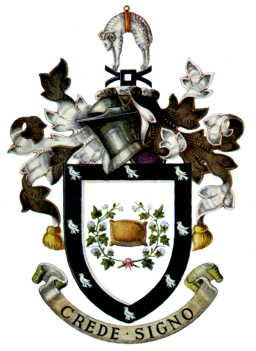
Rochdale has been part of Lancashire since the early 1100s. In 1066, a Saxon leader named Gamel held the area.
The old church area of Rochdale was split into four parts: Butterworth, Castleton, Hundersfield, and Spotland. Hundersfield was later divided into four more parts.
In 1825, people started working to improve the town. In 1832, Rochdale became part of a parliamentary borough. In 1856, Rochdale became a municipal borough. This gave it special powers to manage itself.
Over the years, more areas were added to the borough. In 1872, parts of Wardleworth and other townships joined. In 1900, most of Castleton was added.
In 1888, Rochdale became a County Borough. This meant it was separate from the main Lancashire County Council. In 1972, this special status ended. Now, Rochdale is one of ten metropolitan boroughs in Greater Manchester. Other towns like Middleton and Heywood are also part of the Metropolitan Borough of Rochdale.
Rochdale's Parliament Members
The Rochdale area has had its own Member of Parliament (MP) since 1832.
Recently, Tony Lloyd (Labour Party) was the MP for Rochdale. He was elected in 2017 and passed away in 2024. After that, George Galloway became the MP in a special election. Then, in the 2024 election, Paul Waugh from the Labour Party won the seat.
Rochdale's Location and Landscape
Rochdale is about 450 feet (137 meters) above sea level. It's about 10 miles (16 km) north-north-east of Manchester city centre. The town is in the valley of the River Roch. To the east, you can find Blackstone Edge, Saddleworth Moor, and the South Pennines hills. On other sides, Rochdale is surrounded by other towns. These include Whitworth, Littleborough, Milnrow, Royton, Heywood, and Shaw and Crompton. There isn't much open green space between them.
Rochdale has a mix of buildings. You'll see old houses, modern buildings, and shops. Many houses are stone or red-brick terraced houses from the late 1800s and early 1900s.
Rochdale's Town Hall and seven tall apartment buildings (nicknamed The Seven Sisters) stand out in the skyline. You can also see many old cotton mills. The town's shape is a bit uneven because of the hilly land.
Most of Rochdale's buildings are in the town centre. This area is the main hub for the town and the wider borough.
 |
Norden | Whitworth | Littleborough |  |
| Heywood | Milnrow | |||
| Middleton | Royton | Shaw and Crompton |
Rochdale has busy city areas, quieter suburbs, and some countryside. But most of the land is used for urban development.
Rochdale is the fifth largest settlement in the Greater Manchester Urban Area. This area is the third largest group of connected towns in the United Kingdom.
Rochdale's Neighbourhoods
- Ashworth
- Balderstone
- Bamford
- Belfield
- Buckley
- Buersil
- Burnedge
- Caldershaw
- Castleton
- Cronkeyshaw
- Cutgate
- Deeplish
- Dernley
- Falinge
- Fieldhouse
- Firgrove
- Foxholes
- Halfacre
- Hamer
- Healey
- Hurstead
- Kingsway
- Kirkholt
- Littleborough
- Lowerfold
- Lowerplace
- Marland
- Meanwood
- Newbold
- Nook Farm
- Norden
- Oakenrod
- Oulder Hill
- Passmonds
- Prickshaw
- Rooley Moor
- Shawclough
- Smallbridge
- Smithy Bridge
- Sparth Bottom
- Spotland
- Sudden
- Syke
- Thornham
- Turf Hill
- Wardleworth
Rochdale's Climate
Like most of the British Isles, Rochdale has a mild maritime climate. This means it has fairly cool summers and mild winters.
| Climate data for Rochdale (1991–2020) | |||||||||||||
|---|---|---|---|---|---|---|---|---|---|---|---|---|---|
| Month | Jan | Feb | Mar | Apr | May | Jun | Jul | Aug | Sep | Oct | Nov | Dec | Year |
| Mean daily maximum °C (°F) | 6.9 (44.4) |
7.5 (45.5) |
9.6 (49.3) |
12.5 (54.5) |
15.6 (60.1) |
18.2 (64.8) |
20.0 (68.0) |
19.6 (67.3) |
17.1 (62.8) |
13.4 (56.1) |
9.7 (49.5) |
7.2 (45.0) |
13.1 (55.6) |
| Mean daily minimum °C (°F) | 1.5 (34.7) |
1.4 (34.5) |
2.5 (36.5) |
4.5 (40.1) |
7.2 (45.0) |
10.1 (50.2) |
11.9 (53.4) |
11.8 (53.2) |
9.6 (49.3) |
6.8 (44.2) |
3.9 (39.0) |
1.5 (34.7) |
6.1 (43.0) |
| Average rainfall mm (inches) | 119.2 (4.69) |
97.1 (3.82) |
89.9 (3.54) |
68.4 (2.69) |
65.7 (2.59) |
82.9 (3.26) |
96.9 (3.81) |
100.2 (3.94) |
97.8 (3.85) |
116.8 (4.60) |
123.5 (4.86) |
138.9 (5.47) |
1,197.2 (47.13) |
| Average rainy days (≥ 1 mm) | 17.1 | 13.7 | 13.4 | 11.8 | 10.9 | 12.6 | 13.1 | 14.8 | 13.2 | 15.3 | 17.2 | 17.6 | 170.8 |
| Mean monthly sunshine hours | 32.2 | 49.8 | 98.9 | 152.7 | 175.4 | 152.8 | 170.8 | 153.5 | 116.3 | 78.7 | 41.6 | 42.7 | 1,265.5 |
| Source: Met Office | |||||||||||||
People of Rochdale
In 2021, Rochdale had a population of 111,261 people.
- About 57.2% of people were White.
- About 34.3% were Asian.
- About 2.6% were Mixed ethnicity.
- About 3.4% were Black.
- About 2.1% were Other, and 0.5% were Arab.
When it comes to religion:
- About 38% of people were Christian.
- About 36% were Muslim.
- About 24.2% said they had no religion.
- There are also small Hindu, Sikh, Buddhist, and Jewish communities.
Sadly, more than 40% of children in the wider Rochdale borough live in poverty.
Famous Landmarks in Rochdale
Rochdale has four buildings that are listed as Grade I. This means they are very important and protected. These are:
- The Town Hall
- The Cenotaph (a war memorial)
- The Church of St Mary in the Baum
- St Edmund's Church
Rochdale Town Hall
Rochdale Town Hall is a beautiful building from the Victorian era. Many people say it's one of the best town halls in the country. It's where the local council meets. It also has the office for registering births, deaths, and marriages.
The Town Hall was built in the Gothic Revival style. It opened on September 27, 1871. It used to have a very tall clock tower. But this tower was destroyed by fire in 1883. A new stone clock tower was built in 1888. It was designed to look like the one at Manchester Town Hall.
Art experts have called the building "beautiful." Its stained glass windows are also very special. Some of them were designed by William Morris.
There's a story that Adolf Hitler liked the building so much. He supposedly wanted to move it, brick by brick, to Germany if his country won World War II.
The Rochdale Cenotaph
The Rochdale Cenotaph is a war memorial. It stands across from the Town Hall. It remembers all the people who died in wars since the First World War. This monument was designed by Sir Edwin Lutyens. It's one of only eight he designed in England.
The Cenotaph is made from Cornish granite. It's about 10 meters tall. It was built on the site of an old building called Manor House. This house was used for recruiting soldiers during World War I. The monument was unveiled in 1922.
Next to the Town Hall, you'll find a statue of the famous singer and comedian Dame Gracie Fields. The statue was unveiled in 2016. It was the first statue of a woman in Greater Manchester in over 100 years.
In Broadfield Park, there's a statue of John Bright MP. He was a British politician born in Rochdale. He was known for his great speeches. He fought for free trade and changes to voting laws.
Rochdale also has a large business area called Kingsway Business Park. It covers about 420 acres (1.7 square kilometers).
Getting Around Rochdale
Public transport in Rochdale is managed by Transport for Greater Manchester (TfGM). They own the bus station and help organize transport services.
Trains and Metrolink
The Manchester and Leeds Railway opened in 1839. This helped connect Rochdale to other towns for trade.
Rochdale railway station is about a mile south of the town center. You can catch trains to places like Leeds, Manchester Victoria, Halifax, and Bradford.
The Metrolink is a light rail system. It was extended to Rochdale railway station in 2013. Then, in 2014, it was extended into Rochdale town center. Metrolink services now go to East Didsbury tram stop, through Manchester city center.
Buses
Rochdale has a new bus station called Rochdale Interchange. It's next to the council office building. It's also connected to the Metrolink tram stop.
You can catch frequent bus services to nearby towns like Middleton, Royton, and Oldham. There are also services to Manchester city center. Buses also go to other areas like Rawtenstall and Todmorden.
Roads
The oldest routes around Rochdale were simple tracks. A paved track over Blackstone Edge, which had Roman origins, led into Yorkshire. Later, in 1735, the Blackstone Edge turnpike road was built.
The M62 motorway passes south of Rochdale. You can get to it using the A627(M) road. This road also connects to Oldham.
Canals
The idea for the Rochdale Canal came about in 1776. It was built to connect the Bridgewater Canal in Manchester with the Aire and Calder Navigation at Sowerby Bridge. This canal became a very important way to move goods like cotton, wool, and coal between Lancashire and Yorkshire. The Rochdale Canal has 91 locks over 32 miles (51 km).
Hollingworth Lake is part of the canal system. It was built to control water levels for the canal. By the 1950s, the canal was not used much. It was closed in the 1960s. But parts of it were restored in 1974. The rest of the canal was restored and reopened in 2003. Local groups have worked hard to make the canal even better.
Learning in Rochdale
Hopwood Hall College has a campus in Rochdale. It offers courses for students leaving school and for adults.
Rochdale Sixth Form College opened in 2010. It's the main place for students to study A-Level courses in Rochdale. Most secondary schools in the area no longer offer these courses.
Media and News
You can watch local news and TV shows from BBC North West and ITV Granada.
Local radio stations include BBC Radio Manchester, Heart North West, and Smooth North West. There's also Rochdale Valley, a community radio station.
Rochdale has a local newspaper called the Rochdale Observer. You can also read the regional newspaper, the Manchester Evening News.
Places of Worship
St Chad's Church is a very old church. It was founded before 1170. Much of the building you see today was restored in the late Victorian era. Another important Anglican church is the Church of St Mary in the Baum.
St John the Baptist Catholic Church was built in 1927. It has a special Byzantine Revival style.
Rochdale is also home to 21 mosques. Rochdale Central Masjid is the largest mosque in the town.
Public Services
Police services in Rochdale are provided by Greater Manchester Police. The main police station is at Town Meadow.
Fire and rescue services are provided by the Greater Manchester Fire and Rescue Service. They have fire stations in Rochdale, Littleborough, and Heywood.
Healthcare is provided by Northern Care Alliance. They run four hospitals in the North Manchester area, including Rochdale Infirmary.
Rochdale Infirmary is the main hospital for the town. It got new facilities after Birch Hill Hospital closed in 2007. Mental health services are located behind the old Birch Hill Hospital.
In 2006, it was announced that the Accident & Emergency (A&E) department at Rochdale Infirmary would close. This caused protests in the town. Now, the closest A&E departments are in Oldham and Bury.
Waste management in Rochdale is handled by the local authority.
Rochdale gets its electricity from Electricity North West. There are no power stations in the town. However, the Scout Moor Wind Farm was built on the moors nearby. It has 26 wind turbines and generates a lot of electricity.
United Utilities manages Rochdale's drinking water and wastewater. Water comes from several reservoirs in the moorland around Rochdale. These include Watergrove, Blackstone Edge, and Greenbooth.
Sports in Rochdale
Rochdale has two professional sports teams:
- Rochdale A.F.C. (football)
- Rochdale Hornets (rugby league)
Both teams play their home games at the Spotland Stadium.
Rochdale AFC was started in 1907. They joined the Football League in 1921. The club has never played in the top two divisions of English football. In 1962, they reached the final of the Football League Cup.
Rochdale Hornets is one of the oldest rugby league teams in the world. They were one of the first 22 clubs to form the Northern Rugby Football Union in 1895.
The town also has amateur rugby league and football clubs. There are two adult amateur football leagues.
Golf courses around Rochdale include Rochdale Golf Club. The town also has several cricket clubs.
Speedway racing used to take place at the Athletic Grounds in the 1920s and 1970s. Peter Collins, a world champion speedway rider, used to ride for the Rochdale Hornets team.
Rochdale's Twin Towns
Rochdale has special partnerships with several towns around the world. These are called twin towns or sister cities:
- Barisal, Bangladesh
- Bielefeld, Germany (since 1953)
- Lviv, Ukraine (since 1992)
- Sahiwal, Pakistan (since 1988)
- Tourcoing, France (since 1956)
The town of Sahiwal has received many gifts from Rochdale. These include fire trucks, ambulances, and money for hospitals.
Notable People from Rochdale
Many interesting people have come from Rochdale:
- The poet Edwin Waugh (1817–1890) was born and grew up here.
- Singers like Piri, Gracie Fields, Lisa Stansfield, and Barb Jungr have connections to the town.
- Bands like Kaliphz (also known as Kaleef), Autechre, and Tractor are from Rochdale.
- Broadcasters John Peel and Mark Chapman also have links to the town.
- Actors Anna Friel, Bill Oddie, and Christine Bottomley were born in Rochdale.
- Don Estelle, a famous actor, lived much of his life in Rochdale.
- Sajid Javid, a former government minister, was born in Rochdale.
- Novelist Anna Jacobs was born here.
- World Series of poker winner Jake Cody grew up in Rochdale.
- Footballers like Earl Barrett, Craig Dawson, and Keira Walsh are from Rochdale. A mural of Keira Walsh playing for the Lionesses was painted in June 2024.
Images for kids
See also
 In Spanish: Rochdale para niños
In Spanish: Rochdale para niños






